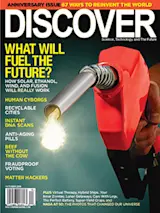The electronic voting machines that one-third of American voters will be using in November are no more reliable than your home computer. Technology has actually taken us a step backward. Paper itself was never fraudproof (remember those chads?), but a stolen, lost, or stuffed ballot box risks mere hundreds of votes while a hidden computer glitch risks millions. Transparency—not just of the software code, but of the whole voting system—has never been more important.
Each voter should be able to verify that his or her own vote has been counted correctly from the booth all the way to the final tally. But how can you lay bare the secret ballot without sacrificing the privacy that makes democracy work?
Invisible ink, according to top security experts. Really.
Our current digital democracy leaves massive fraud and massive error imperceptible and untrackable. Direct-recording electronic voting machines in particular are easy to hack; Princeton ...















